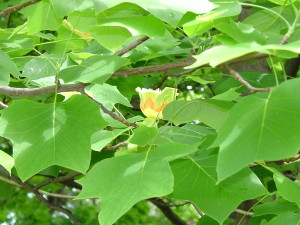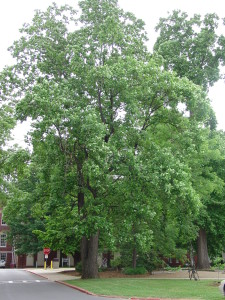Tulip poplar (Liriodendron tulipifera), aka yellow poplar and tulip tree, is a large stately deciduous tree of eastern North America (USDA hardiness zones 4-9). This fast growing native typically grows 60-90 feet tall. It is also an important timber tree.
A member of the magnolia family, flowers attract large numbers of bees. Ornate 2-inch-wide goblet-shaped flowers are yellow with an orange band at the base of each petal. Most flowers go unnoticed, hidden among the 8- inch-wide leaves that have emerged a week or two prior. Dry, scaly, cone-shaped brown fruits follow, each bearing numerous winged seeds. In some years (not all), bright green tulip shaped foliage turns golden yellow in fall.
The size of this native tree will become menacing to homeowners. Young tulip poplars grow with a pyramidal form and mature with a broad rounded canopy. Trunks of mature trees may reach 4-6 feet in diameter, usually rising column-like and devoid of lower branches. Tulip poplars grow rapidly and become too big for an average residential property. Branches are not weak wooded in the early years, but weighty branches on older trees tend to snap off branches in wind and ice storms. Shallow rootsystem grow in lawns and will likely uplift sidewalks in urban areas.
Although not prone to serious disease and insect problems, leaves may be plagued by sap feeding aphids which exude sticky sap over decks, patios and cars beneath. Over a dry summer tulip tree may shed up to one-third of their leaves, perhaps abit messy for some homeowners. Shallow root systems do limit the types of plants that may be grown within the drip line. During hot, dry weather the leaves tend to turn yellow and drop off.
Leading cultivars:
‘Arnold’ – columnar 50 feet tall and 20-25 feet wide
‘Aureomarginatum’ – green with gold leaf edge
‘Little Volunteer’ – compact 35-40 feet tall and 30-35 feet wide



 Posted in
Posted in 
